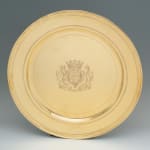



a VN in heart
A William III Antique English Silver-Gilt Sideboard Dish, 1700
20”
Weight: 82
London
V9858
$ 95,000.00
Further images
The arms are those of John Holles (1662-1711), 3rd Duke of Newcastle-Upon-Tyne, and his wife (and first cousin) Margaret, 3rd daughter and co-heiress of Henry Cavendish, 2nd Duke of Newcastle-Upon-Tyne....
The arms are those of John Holles (1662-1711), 3rd Duke of Newcastle-Upon-Tyne, and his wife (and first cousin) Margaret, 3rd daughter and co-heiress of Henry Cavendish, 2nd Duke of Newcastle-Upon-Tyne. Holles had succeeded as the 4th Earl of Clare in 1689, and inherited the greater part of the Cavendish estates in 1691 on the death of Margaret’s father. Having taken an active part in promoting the accession of King William III, he now applied to the King for a Dukedom and to be made a Knight of the Garter. His brothers-in-law, the Earls of Thanet and Montague, disputed the 2nd Duke’s will. They were unsuccessful, but the dispute resulted in a duel between the Earl of Clare and the Earl of Thanet in 1692. Both men were wounded.
Because the King had only promised to consider the Earl of Clare’s request for a Dukedom, the Earl resigned all of appointments as Gentleman of the Bedchamber and Lord Lieutenant of Middlesex, and retreated to his estates in Welbeck in Nottinghamshire. In 1693 he inherited another fortune from the 3rd Lord Hollis, becoming one of the richest men in England. The King now promised him the title of Duke of Clarence, only to discover that this title was reserved for Princes of the Blood Royal, so he was consequently created Duke of Newcastle in 1694. To compensate him for the substitution in title, the King promised him the next available Garter, which he received in 1698. The Duke sumptuously entertained the King at Welbeck Abbey in 1695.
The Duke became Lord Privy Seal in 1705 and was an influential figure in the discussions which ultimately led to the Treaty of Union (with Scotland) in 1707. He was also in receipt of a number of local offices, such as Lord Lieutenant of the North Riding of Yorkshire. He died at Welbeck following a fall from his horse while stag-hunting.
The arms on this piece are unusually complex and impressive, a special grant to use the Vere quarterings having been made to the Duke; his grandfather, John Holles, 2nd Earl of Clare, had married in 1626 Elizabeth, daughter and co-heiress of Horatio Vere, Lord Vere of Tilbury, grandson of John Vere, 15th Earl of Oxford.
A pair of silver-gilt tankards made in 1699 for the Duke and bearing the same arms is in the collection of the Metropolitan Museum of Art (1983.252.1-2). A pair of large wine flasks of 1699 also with these arms is illustrated in Sotheby’s Directory of Silver by Vanessa Brett, fig. 566, p. 150.
The maker of this piece, “VN in a heart”, made a variety of the other pieces that appeared in the 1921 Duke of Newcastle sale catalog.
Provenance:
The 3rd Duke of Newcastle and thence by descent
sold at Christie’s, London, 7 July 1921, lot 61. The matching ewers were in lot 67.
Literature:
The Decorative Arts in England during the late XVIIth and XVIIIth Centuries by H. H. Mulliner, 1923, fig. 94. This is considered to be one of the most important early books on English Decorative Arts.
Because the King had only promised to consider the Earl of Clare’s request for a Dukedom, the Earl resigned all of appointments as Gentleman of the Bedchamber and Lord Lieutenant of Middlesex, and retreated to his estates in Welbeck in Nottinghamshire. In 1693 he inherited another fortune from the 3rd Lord Hollis, becoming one of the richest men in England. The King now promised him the title of Duke of Clarence, only to discover that this title was reserved for Princes of the Blood Royal, so he was consequently created Duke of Newcastle in 1694. To compensate him for the substitution in title, the King promised him the next available Garter, which he received in 1698. The Duke sumptuously entertained the King at Welbeck Abbey in 1695.
The Duke became Lord Privy Seal in 1705 and was an influential figure in the discussions which ultimately led to the Treaty of Union (with Scotland) in 1707. He was also in receipt of a number of local offices, such as Lord Lieutenant of the North Riding of Yorkshire. He died at Welbeck following a fall from his horse while stag-hunting.
The arms on this piece are unusually complex and impressive, a special grant to use the Vere quarterings having been made to the Duke; his grandfather, John Holles, 2nd Earl of Clare, had married in 1626 Elizabeth, daughter and co-heiress of Horatio Vere, Lord Vere of Tilbury, grandson of John Vere, 15th Earl of Oxford.
A pair of silver-gilt tankards made in 1699 for the Duke and bearing the same arms is in the collection of the Metropolitan Museum of Art (1983.252.1-2). A pair of large wine flasks of 1699 also with these arms is illustrated in Sotheby’s Directory of Silver by Vanessa Brett, fig. 566, p. 150.
The maker of this piece, “VN in a heart”, made a variety of the other pieces that appeared in the 1921 Duke of Newcastle sale catalog.
Provenance:
The 3rd Duke of Newcastle and thence by descent
sold at Christie’s, London, 7 July 1921, lot 61. The matching ewers were in lot 67.
Literature:
The Decorative Arts in England during the late XVIIth and XVIIIth Centuries by H. H. Mulliner, 1923, fig. 94. This is considered to be one of the most important early books on English Decorative Arts.



